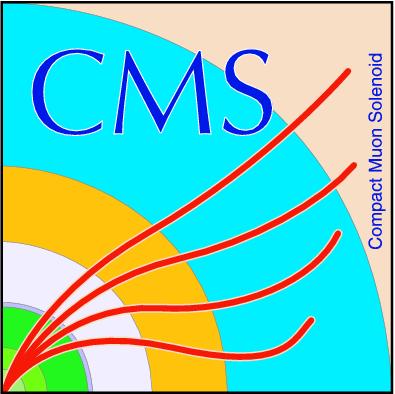

Compact Muon Solenoid
LHC, CERN
| CMS-PAS-SMP-15-007 | ||
| Measurement of the double-differential inclusive jet cross section at √s= 13 TeV | ||
| CMS Collaboration | ||
| December 2015 | ||
| Abstract: A measurement of the double-differential inclusive jet cross section, as a function of jet transverse momentum pT and absolute jet rapidity |y|, is presented. The analysis is based on a data set of proton-proton collisions acquired by the CMS experiment at the LHC during 2015 at a center-of-mass energy of 13 TeV. The collected data correspond to an integrated luminosity of 72 pb−1 for rapidities up to |y|= 3 and 45 pb−1 for the forward rapidity region 3.2 <|y|< 4.7. Jets are reconstructed with the anti-kT clustering algorithm for two jet size parameters R= 0.7 and R= 0.4 in a phase space region covering jet pT up to 2 TeV and jet rapidity up to |y|= 4.7. The results are compared to fixed-order predictions of perturbative QCD and to simulations using various Monte Carlo event generators including parton showers, hadronisation, and multiparton interactions. | ||
|
Links:
CDS record (PDF) ;
CADI line (restricted) ;
These preliminary results are superseded in this paper, EPJC 76 (2016) 451. The superseded preliminary plots can be found here. |
||
| Figures | |
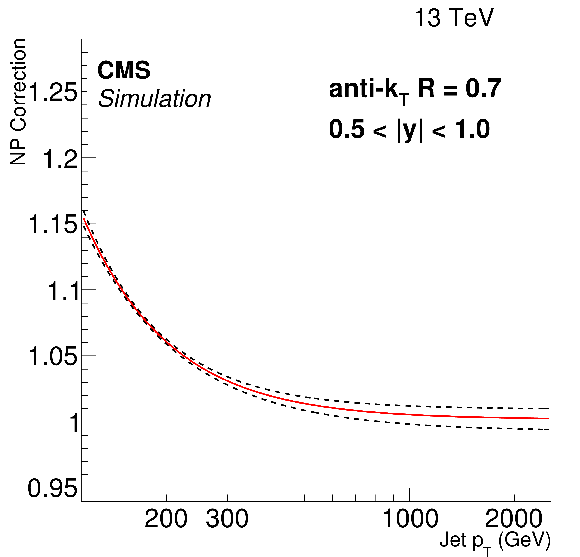
png ; pdf ; |
Figure 1-a:
Fits to the nonperturbative corrections obtained for inclusive AK7 jet cross sections as a function of jet pT for two rapidity bins: 0.5 <|y|< 1.0 (left) and 2.5 <|y|< 3.0 (right). |
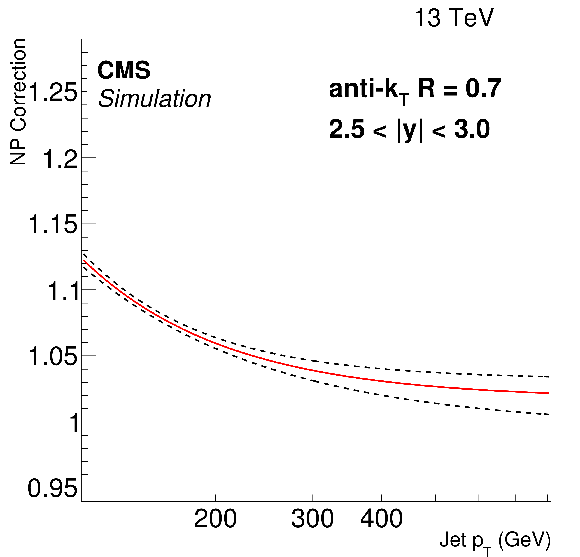
png ; pdf ; |
Figure 1-b:
Fits to the nonperturbative corrections obtained for inclusive AK7 jet cross sections as a function of jet pT for two rapidity bins: 0.5 <|y|< 1.0 (left) and 2.5 <|y|< 3.0 (right). |
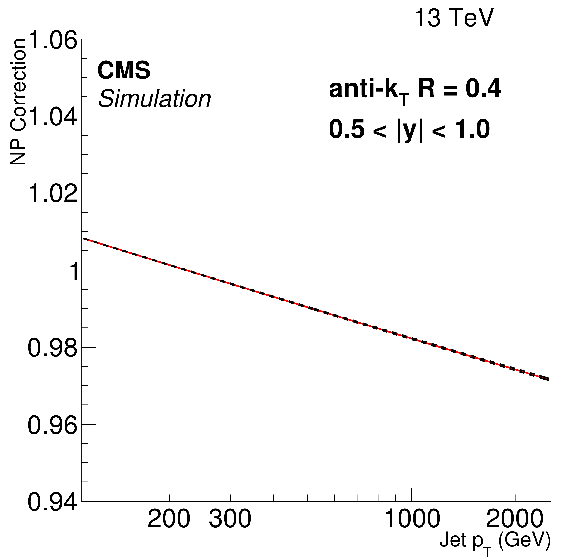
png ; pdf ; |
Figure 2-a:
Fits to the nonperturbative corrections obtained for inclusive AK4 jet cross sections as a function of jet pT for two rapidity bins: 0.5 <|y|< 1.0 (left) and 2.5 <|y|< 3.0 (right). |
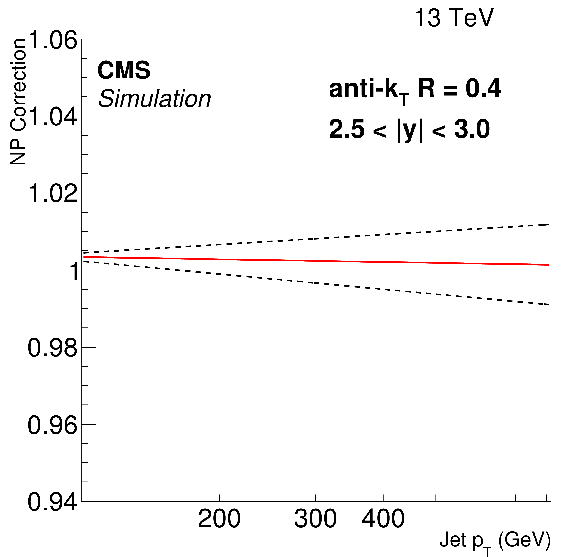
png ; pdf ; |
Figure 2-b:
Fits to the nonperturbative corrections obtained for inclusive AK4 jet cross sections as a function of jet pT for two rapidity bins: 0.5 <|y|< 1.0 (left) and 2.5 <|y|< 3.0 (right). |
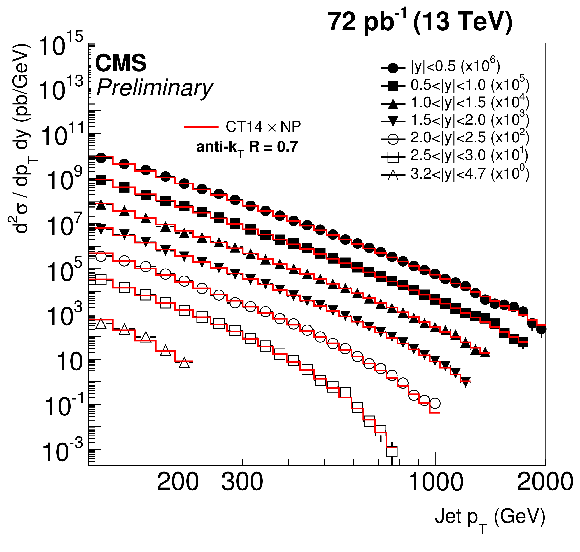
png ; pdf ; |
Figure 3-a:
Double-differential inclusive jet cross section as function of jet pT. On the (a) plot, data (points) and NLOJet++ predictions based on CT14 PDF set corrected for the NP factor (line). On the (b) plot, data (points) and predictions from POWHEG + PYTHIA8 with tune CUETM1 (line). Jets are clustered with the anti-kT algorithm (R= 0.7). |

png ; pdf ; |
Figure 3-b:
Double-differential inclusive jet cross section as function of jet pT. On the (a) plot, data (points) and NLOJet++ predictions based on CT14 PDF set corrected for the NP factor (line). On the (b) plot, data (points) and predictions from POWHEG + PYTHIA8 with tune CUETM1 (line). Jets are clustered with the anti-kT algorithm (R= 0.7). |
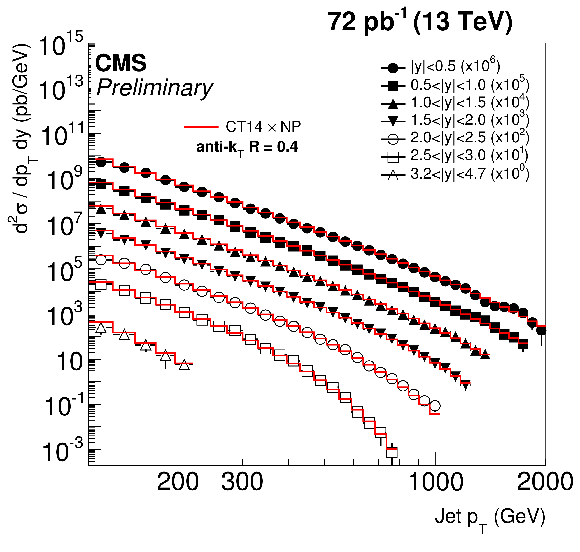
png ; pdf ; |
Figure 4-a:
Double-differential inclusive jet cross section as function of jet pT. On the (a) plot, data (points) and NLOJet++ predictions based on CT14 PDF set corrected for the NP factor (line). On the (b) plot, data (points) and predictions from POWHEG + PYTHIA8 with tune CUETM1 (line). Jets are clustered with the anti-kT algorithm (R= 0.4). |
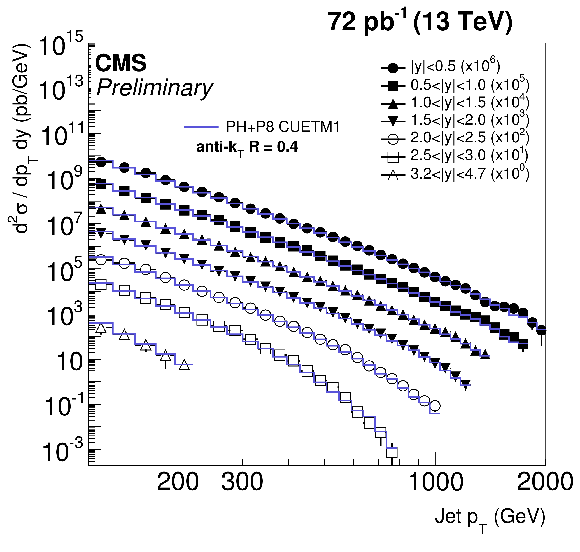
png ; pdf ; |
Figure 4-b:
Double-differential inclusive jet cross section as function of jet pT. On the (a) plot, data (points) and NLOJet++ predictions based on CT14 PDF set corrected for the NP factor (line). On the (b) plot, data (points) and predictions from POWHEG + PYTHIA8 with tune CUETM1 (line). Jets are clustered with the anti-kT algorithm (R= 0.4). |
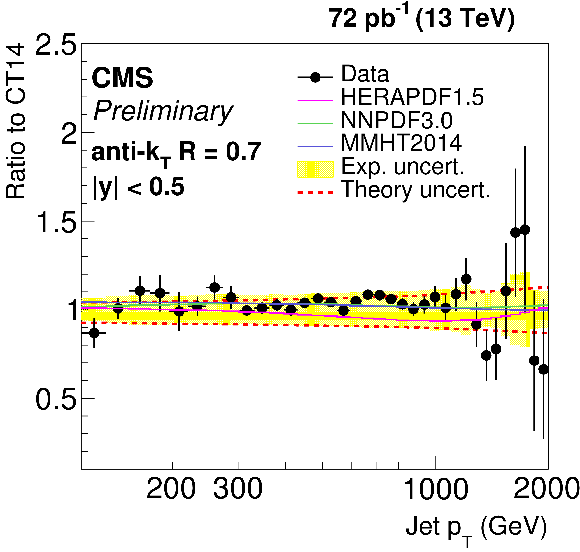
png ; pdf ; |
Figure 5-a:
Ratio of data over theory prediction using the CT14 PDF set. For comparison predictions employing three other PDF sets are also shown. Jets are clustered with the anti-kT algorithm (R= 0.7). The error bars correspond to the statistical uncertainty of the data and the shaded band to the total systematical uncertainty. |
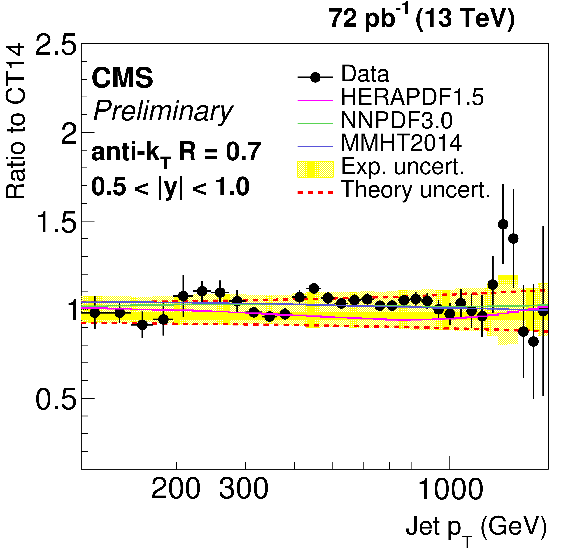
png ; pdf ; |
Figure 5-b:
Ratio of data over theory prediction using the CT14 PDF set. For comparison predictions employing three other PDF sets are also shown. Jets are clustered with the anti-kT algorithm (R= 0.7). The error bars correspond to the statistical uncertainty of the data and the shaded band to the total systematical uncertainty. |
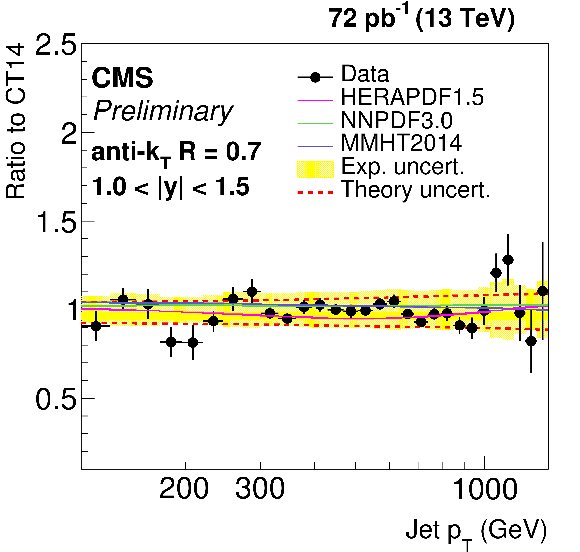
png ; pdf ; |
Figure 5-c:
Ratio of data over theory prediction using the CT14 PDF set. For comparison predictions employing three other PDF sets are also shown. Jets are clustered with the anti-kT algorithm (R= 0.7). The error bars correspond to the statistical uncertainty of the data and the shaded band to the total systematical uncertainty. |
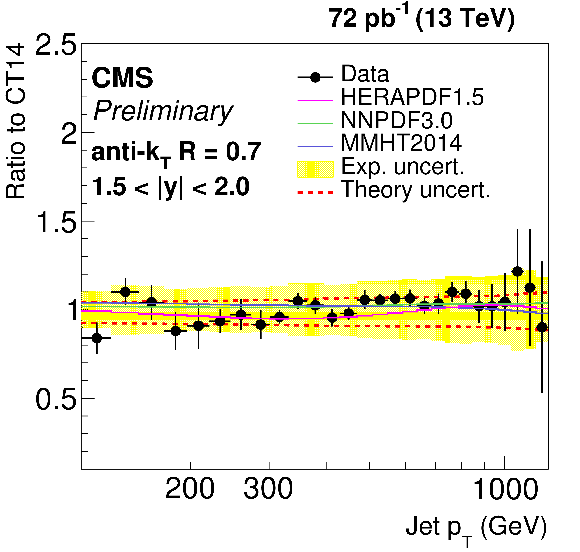
png ; pdf ; |
Figure 5-d:
Ratio of data over theory prediction using the CT14 PDF set. For comparison predictions employing three other PDF sets are also shown. Jets are clustered with the anti-kT algorithm (R= 0.7). The error bars correspond to the statistical uncertainty of the data and the shaded band to the total systematical uncertainty. |
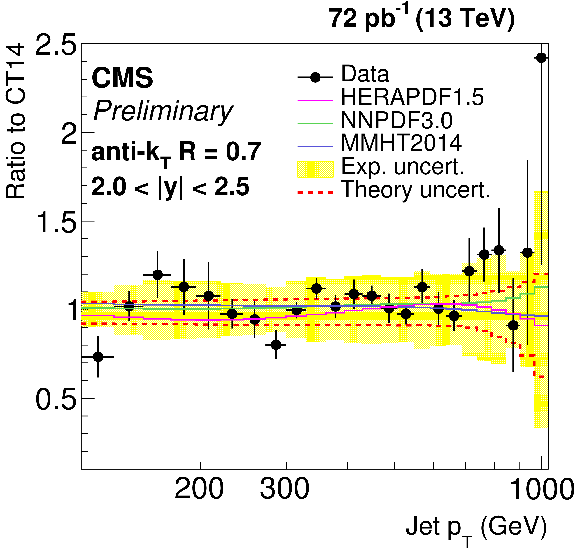
png ; pdf ; |
Figure 5-e:
Ratio of data over theory prediction using the CT14 PDF set. For comparison predictions employing three other PDF sets are also shown. Jets are clustered with the anti-kT algorithm (R= 0.7). The error bars correspond to the statistical uncertainty of the data and the shaded band to the total systematical uncertainty. |
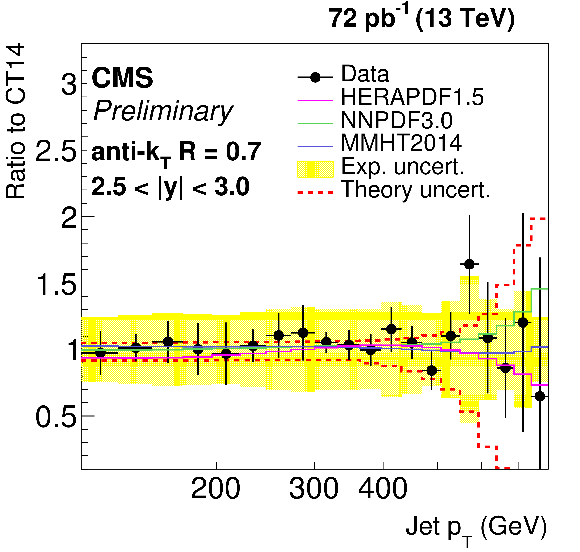
png ; pdf ; |
Figure 5-f:
Ratio of data over theory prediction using the CT14 PDF set. For comparison predictions employing three other PDF sets are also shown. Jets are clustered with the anti-kT algorithm (R= 0.7). The error bars correspond to the statistical uncertainty of the data and the shaded band to the total systematical uncertainty. |
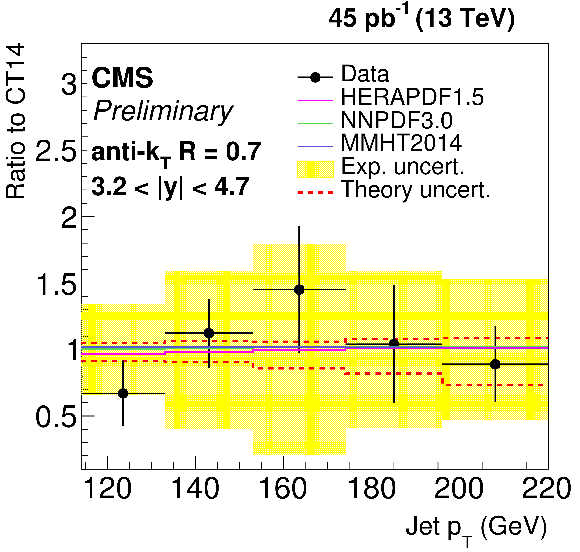
png ; pdf ; |
Figure 5-g:
Ratio of data over theory prediction using the CT14 PDF set. For comparison predictions employing three other PDF sets are also shown. Jets are clustered with the anti-kT algorithm (R= 0.7). The error bars correspond to the statistical uncertainty of the data and the shaded band to the total systematical uncertainty. |
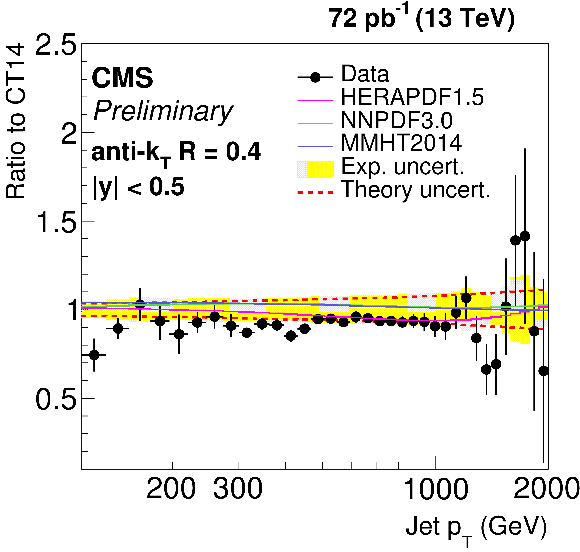
png ; pdf ; |
Figure 6-a:
Ratio of data over theory prediction using the CT14 PDF set. For comparison predictions employing three other PDF sets are also shown. Jets are clustered with the anti-kT algorithm (R= 0.4). The error bars correspond to the statistical uncertainty of the data and the shaded band to the total systematical uncertainty. |

png ; pdf ; |
Figure 6-b:
Ratio of data over theory prediction using the CT14 PDF set. For comparison predictions employing three other PDF sets are also shown. Jets are clustered with the anti-kT algorithm (R= 0.4). The error bars correspond to the statistical uncertainty of the data and the shaded band to the total systematical uncertainty. |
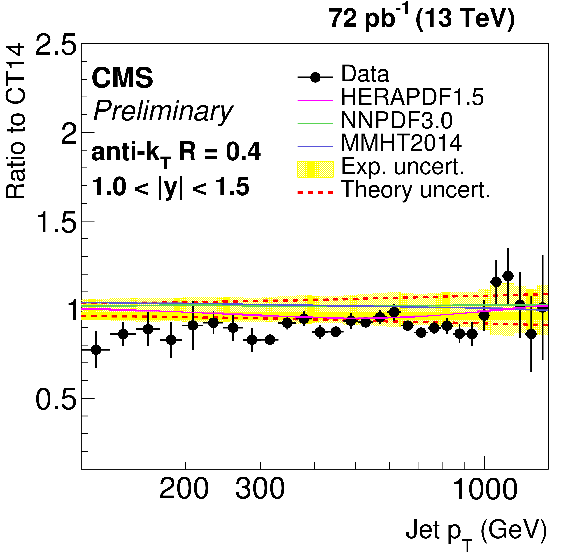
png ; pdf ; |
Figure 6-c:
Ratio of data over theory prediction using the CT14 PDF set. For comparison predictions employing three other PDF sets are also shown. Jets are clustered with the anti-kT algorithm (R= 0.4). The error bars correspond to the statistical uncertainty of the data and the shaded band to the total systematical uncertainty. |
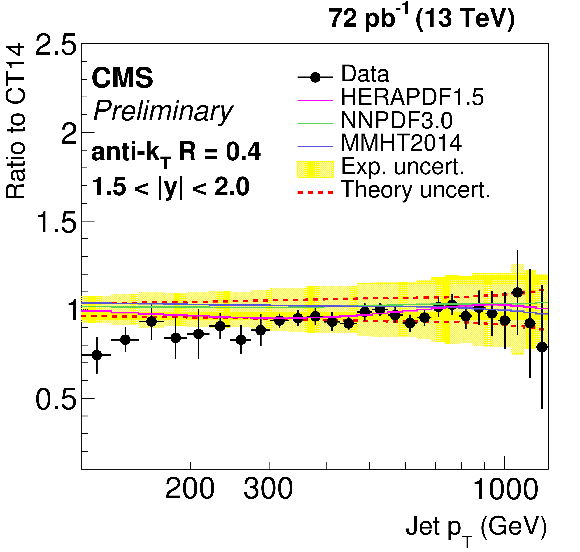
png ; pdf ; |
Figure 6-d:
Ratio of data over theory prediction using the CT14 PDF set. For comparison predictions employing three other PDF sets are also shown. Jets are clustered with the anti-kT algorithm (R= 0.4). The error bars correspond to the statistical uncertainty of the data and the shaded band to the total systematical uncertainty. |
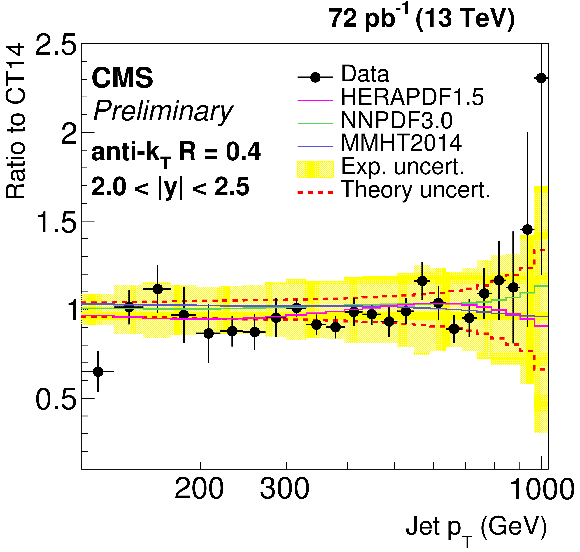
png ; pdf ; |
Figure 6-e:
Ratio of data over theory prediction using the CT14 PDF set. For comparison predictions employing three other PDF sets are also shown. Jets are clustered with the anti-kT algorithm (R= 0.4). The error bars correspond to the statistical uncertainty of the data and the shaded band to the total systematical uncertainty. |
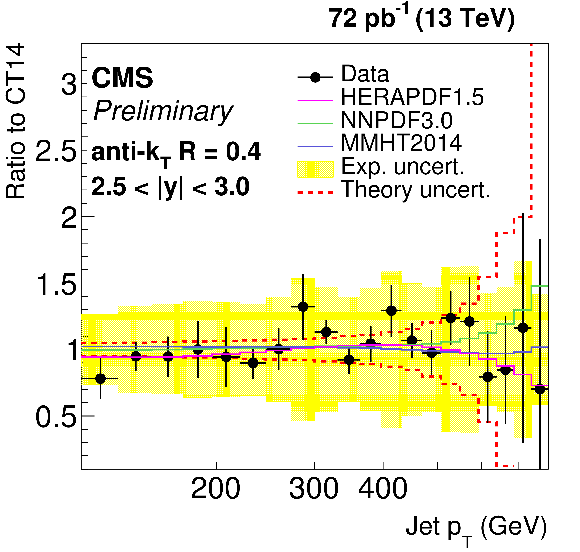
png ; pdf ; |
Figure 6-f:
Ratio of data over theory prediction using the CT14 PDF set. For comparison predictions employing three other PDF sets are also shown. Jets are clustered with the anti-kT algorithm (R= 0.4). The error bars correspond to the statistical uncertainty of the data and the shaded band to the total systematical uncertainty. |
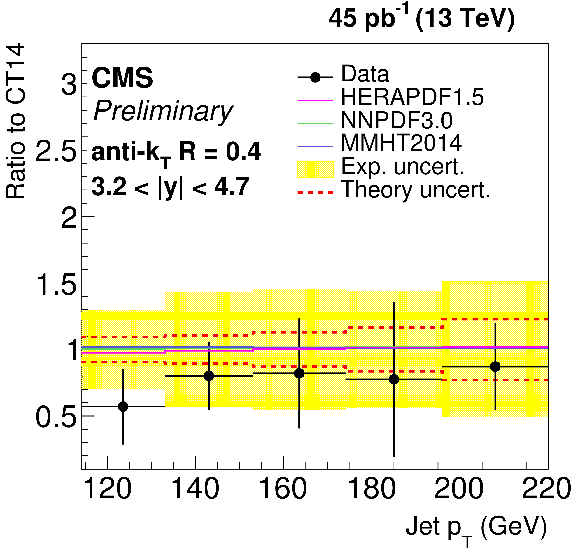
png ; pdf ; |
Figure 6-g:
Ratio of data over theory prediction using the CT14 PDF set. For comparison predictions employing three other PDF sets are also shown. Jets are clustered with the anti-kT algorithm (R= 0.4). The error bars correspond to the statistical uncertainty of the data and the shaded band to the total systematical uncertainty. |
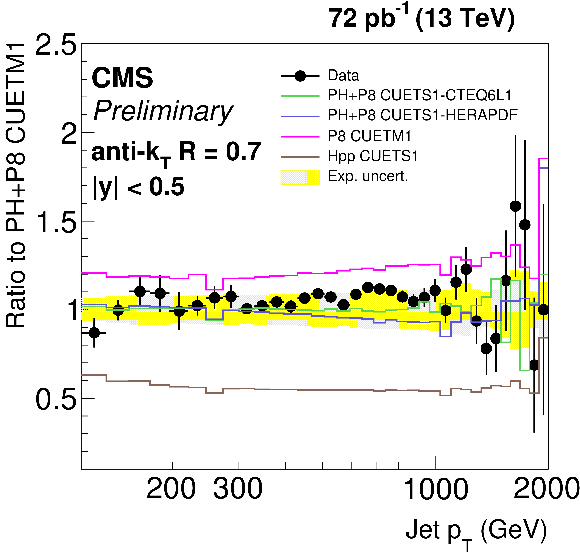
png ; pdf ; |
Figure 7-a:
Ratio of data over predictions from POWHEG + PYTHIA8 with tune CUETM1. For comparison predictions employing four other MC generators are also shown, where PH, P8 and Hpp stands for POWHEG , PYTHIA8 and HERWIG++ respectively. Jets are clustered with the anti-kT algorithm (R= 0.7). The error bars correspond to the statistical uncertainty of the data and the shaded band to the total systematical uncertainty. |
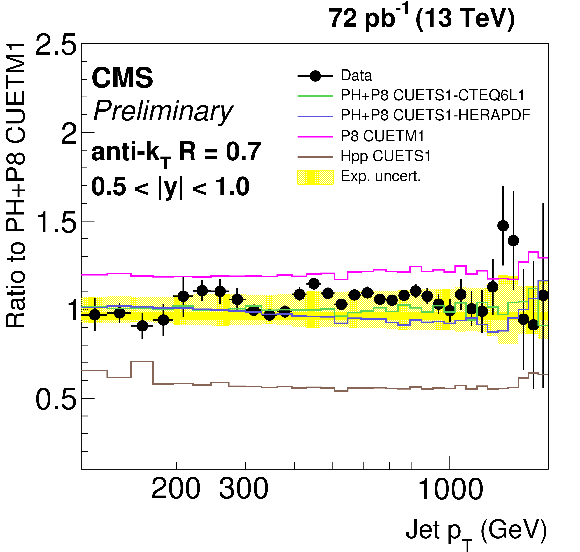
png ; pdf ; |
Figure 7-b:
Ratio of data over predictions from POWHEG + PYTHIA8 with tune CUETM1. For comparison predictions employing four other MC generators are also shown, where PH, P8 and Hpp stands for POWHEG , PYTHIA8 and HERWIG++ respectively. Jets are clustered with the anti-kT algorithm (R= 0.7). The error bars correspond to the statistical uncertainty of the data and the shaded band to the total systematical uncertainty. |
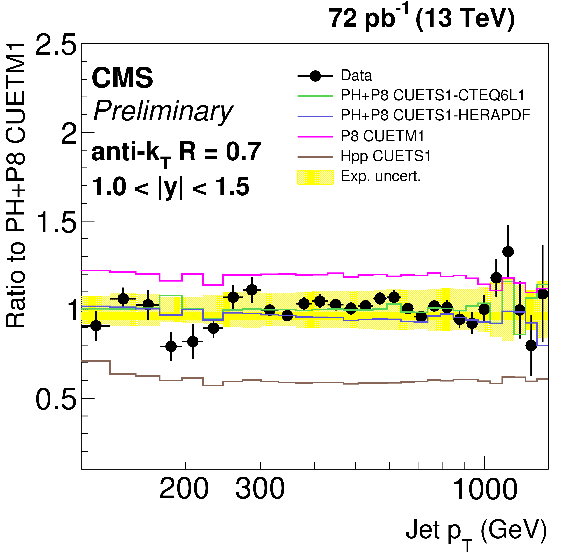
png ; pdf ; |
Figure 7-c:
Ratio of data over predictions from POWHEG + PYTHIA8 with tune CUETM1. For comparison predictions employing four other MC generators are also shown, where PH, P8 and Hpp stands for POWHEG , PYTHIA8 and HERWIG++ respectively. Jets are clustered with the anti-kT algorithm (R= 0.7). The error bars correspond to the statistical uncertainty of the data and the shaded band to the total systematical uncertainty. |
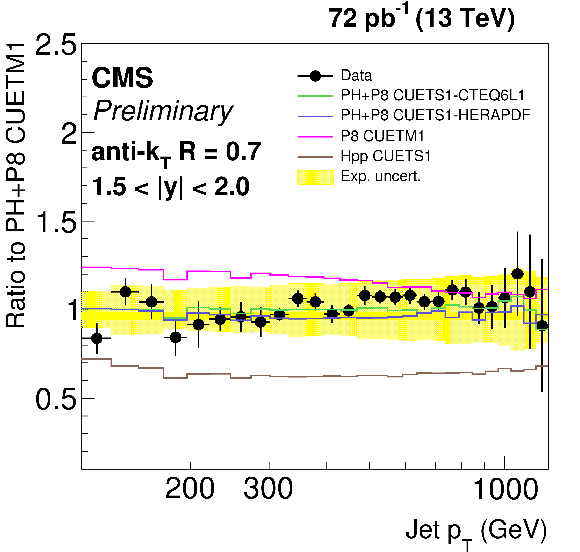
png ; pdf ; |
Figure 7-d:
Ratio of data over predictions from POWHEG + PYTHIA8 with tune CUETM1. For comparison predictions employing four other MC generators are also shown, where PH, P8 and Hpp stands for POWHEG , PYTHIA8 and HERWIG++ respectively. Jets are clustered with the anti-kT algorithm (R= 0.7). The error bars correspond to the statistical uncertainty of the data and the shaded band to the total systematical uncertainty. |
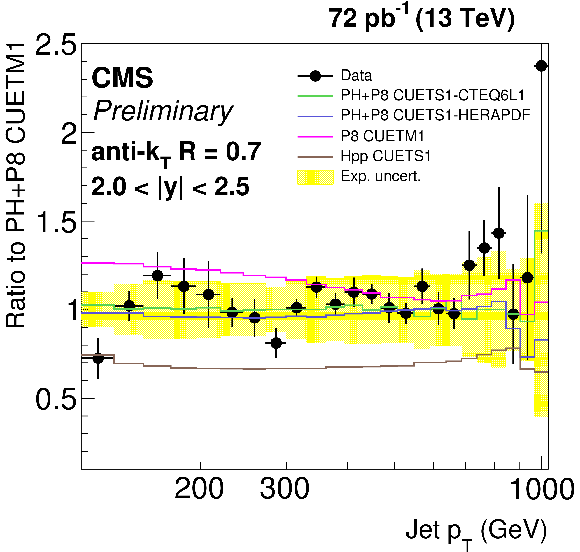
png ; pdf ; |
Figure 7-e:
Ratio of data over predictions from POWHEG + PYTHIA8 with tune CUETM1. For comparison predictions employing four other MC generators are also shown, where PH, P8 and Hpp stands for POWHEG , PYTHIA8 and HERWIG++ respectively. Jets are clustered with the anti-kT algorithm (R= 0.7). The error bars correspond to the statistical uncertainty of the data and the shaded band to the total systematical uncertainty. |
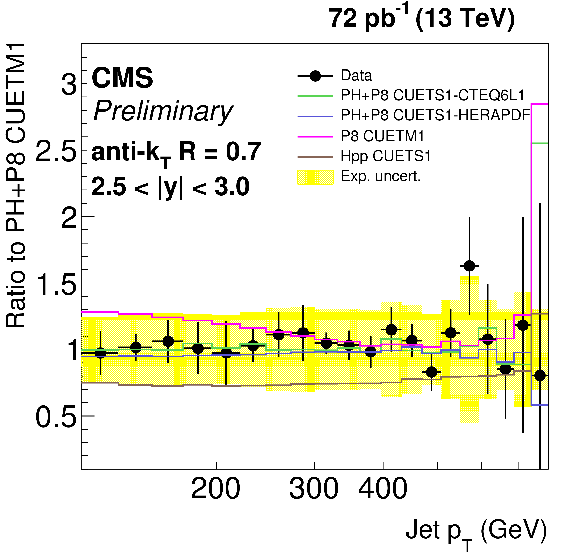
png ; pdf ; |
Figure 7-f:
Ratio of data over predictions from POWHEG + PYTHIA8 with tune CUETM1. For comparison predictions employing four other MC generators are also shown, where PH, P8 and Hpp stands for POWHEG , PYTHIA8 and HERWIG++ respectively. Jets are clustered with the anti-kT algorithm (R= 0.7). The error bars correspond to the statistical uncertainty of the data and the shaded band to the total systematical uncertainty. |
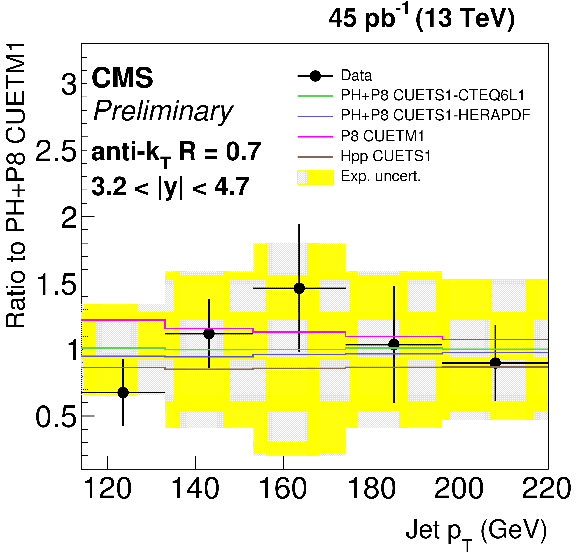
png ; pdf ; |
Figure 7-g:
Ratio of data over predictions from POWHEG + PYTHIA8 with tune CUETM1. For comparison predictions employing four other MC generators are also shown, where PH, P8 and Hpp stands for POWHEG , PYTHIA8 and HERWIG++ respectively. Jets are clustered with the anti-kT algorithm (R= 0.7). The error bars correspond to the statistical uncertainty of the data and the shaded band to the total systematical uncertainty. |

png ; pdf ; |
Figure 8-a:
Ratio of data over predictions from POWHEG + PYTHIA8 with tune CUETM1. For comparison predictions employing four other MC generators are also shown, where PH, P8 and Hpp stands for POWHEG , PYTHIA8 and HERWIG++ respectively. Jets are clustered with the anti-kT algorithm (R= 0.4). The error bars correspond to the statistical uncertainty of the data and the shaded band to the total systematical uncertainty. |
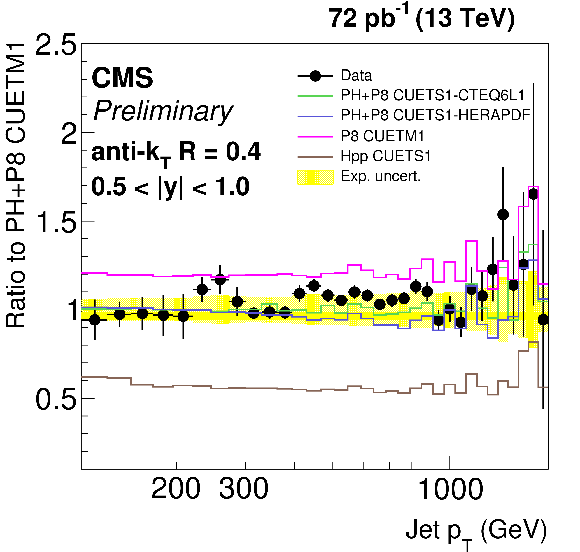
png ; pdf ; |
Figure 8-b:
Ratio of data over predictions from POWHEG + PYTHIA8 with tune CUETM1. For comparison predictions employing four other MC generators are also shown, where PH, P8 and Hpp stands for POWHEG , PYTHIA8 and HERWIG++ respectively. Jets are clustered with the anti-kT algorithm (R= 0.4). The error bars correspond to the statistical uncertainty of the data and the shaded band to the total systematical uncertainty. |
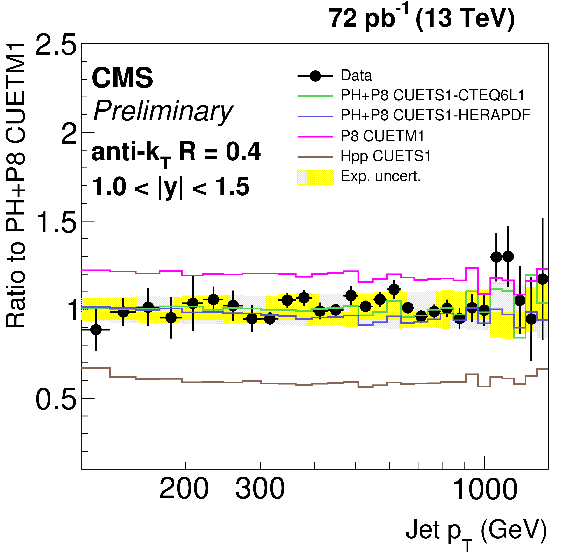
png ; pdf ; |
Figure 8-c:
Ratio of data over predictions from POWHEG + PYTHIA8 with tune CUETM1. For comparison predictions employing four other MC generators are also shown, where PH, P8 and Hpp stands for POWHEG , PYTHIA8 and HERWIG++ respectively. Jets are clustered with the anti-kT algorithm (R= 0.4). The error bars correspond to the statistical uncertainty of the data and the shaded band to the total systematical uncertainty. |
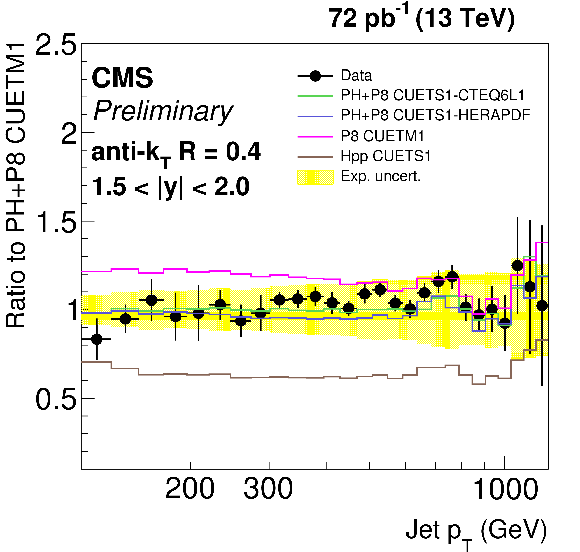
png ; pdf ; |
Figure 8-d:
Ratio of data over predictions from POWHEG + PYTHIA8 with tune CUETM1. For comparison predictions employing four other MC generators are also shown, where PH, P8 and Hpp stands for POWHEG , PYTHIA8 and HERWIG++ respectively. Jets are clustered with the anti-kT algorithm (R= 0.4). The error bars correspond to the statistical uncertainty of the data and the shaded band to the total systematical uncertainty. |
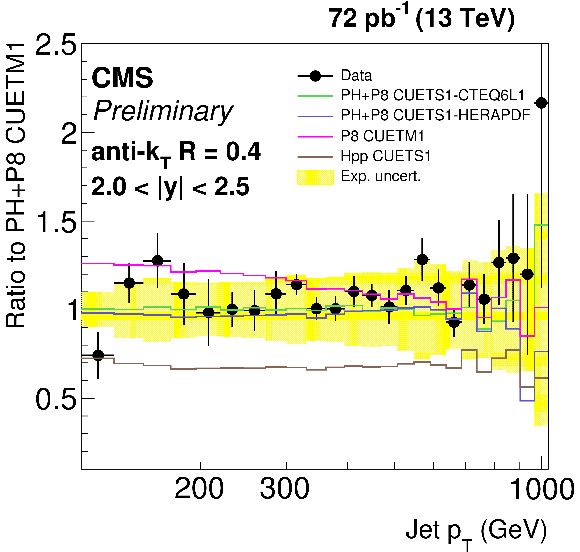
png ; pdf ; |
Figure 8-e:
Ratio of data over predictions from POWHEG + PYTHIA8 with tune CUETM1. For comparison predictions employing four other MC generators are also shown, where PH, P8 and Hpp stands for POWHEG , PYTHIA8 and HERWIG++ respectively. Jets are clustered with the anti-kT algorithm (R= 0.4). The error bars correspond to the statistical uncertainty of the data and the shaded band to the total systematical uncertainty. |
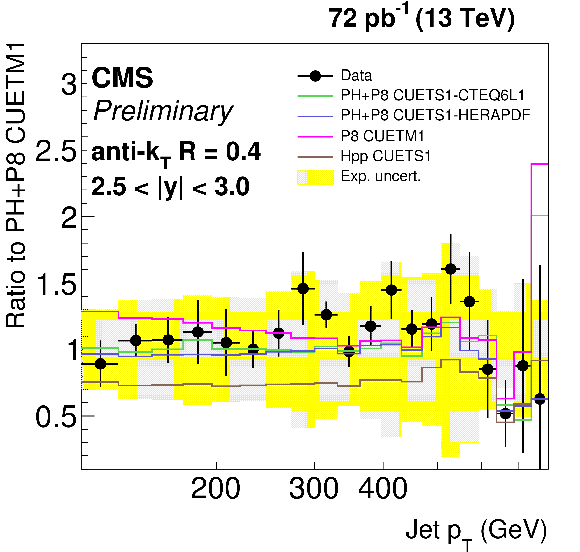
png ; pdf ; |
Figure 8-f:
Ratio of data over predictions from POWHEG + PYTHIA8 with tune CUETM1. For comparison predictions employing four other MC generators are also shown, where PH, P8 and Hpp stands for POWHEG , PYTHIA8 and HERWIG++ respectively. Jets are clustered with the anti-kT algorithm (R= 0.4). The error bars correspond to the statistical uncertainty of the data and the shaded band to the total systematical uncertainty. |
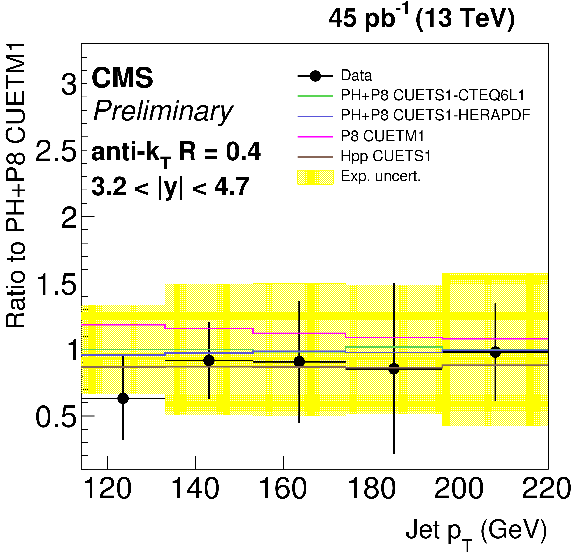
png ; pdf ; |
Figure 8-g:
Ratio of data over predictions from POWHEG + PYTHIA8 with tune CUETM1. For comparison predictions employing four other MC generators are also shown, where PH, P8 and Hpp stands for POWHEG , PYTHIA8 and HERWIG++ respectively. Jets are clustered with the anti-kT algorithm (R= 0.4). The error bars correspond to the statistical uncertainty of the data and the shaded band to the total systematical uncertainty. |
| Tables | |
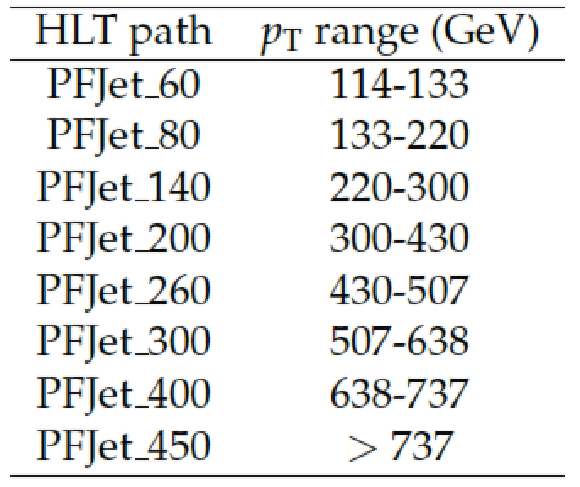
png ; pdf |
Table 1:
Trigger regions defined as ranges of the leading jet pT in each event for every single jet trigger used in the inclusive jet cross section measurement. |

|
Compact Muon Solenoid LHC, CERN |

|
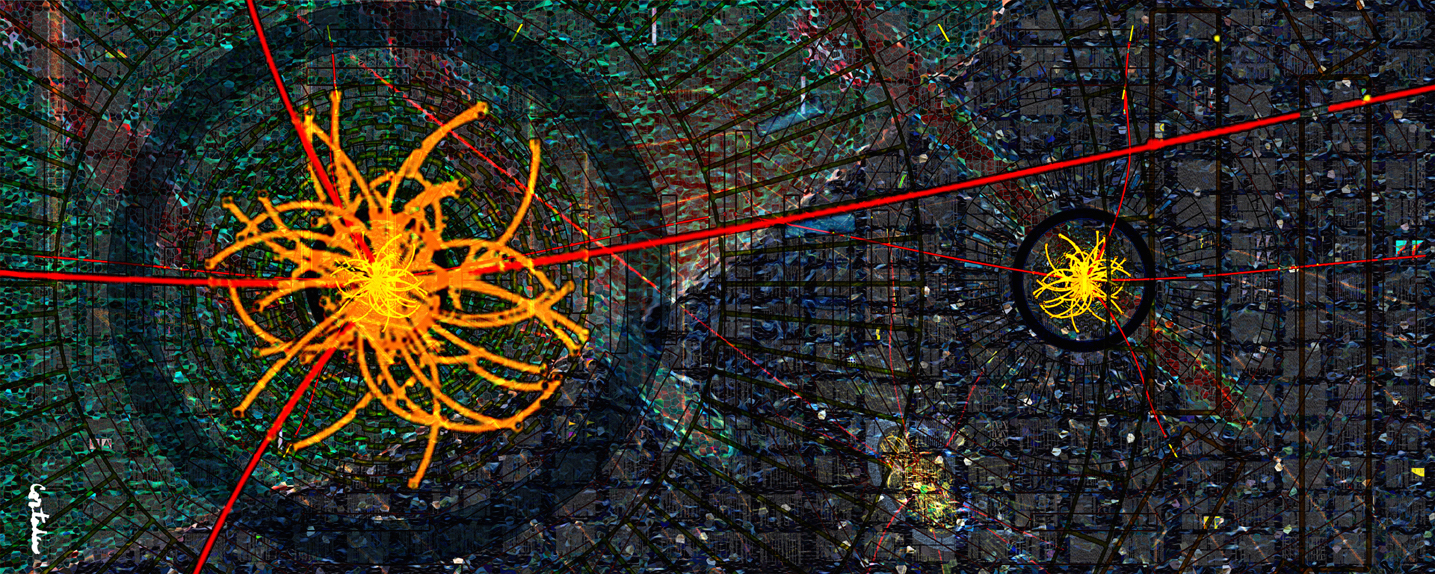
|
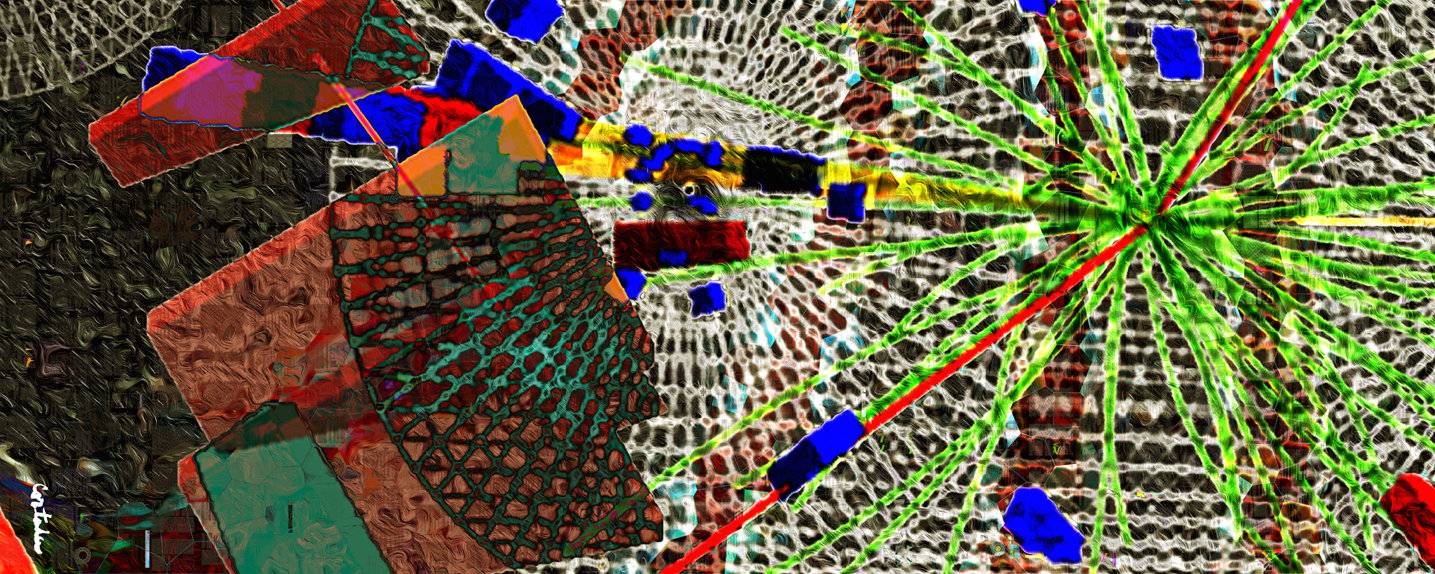
|
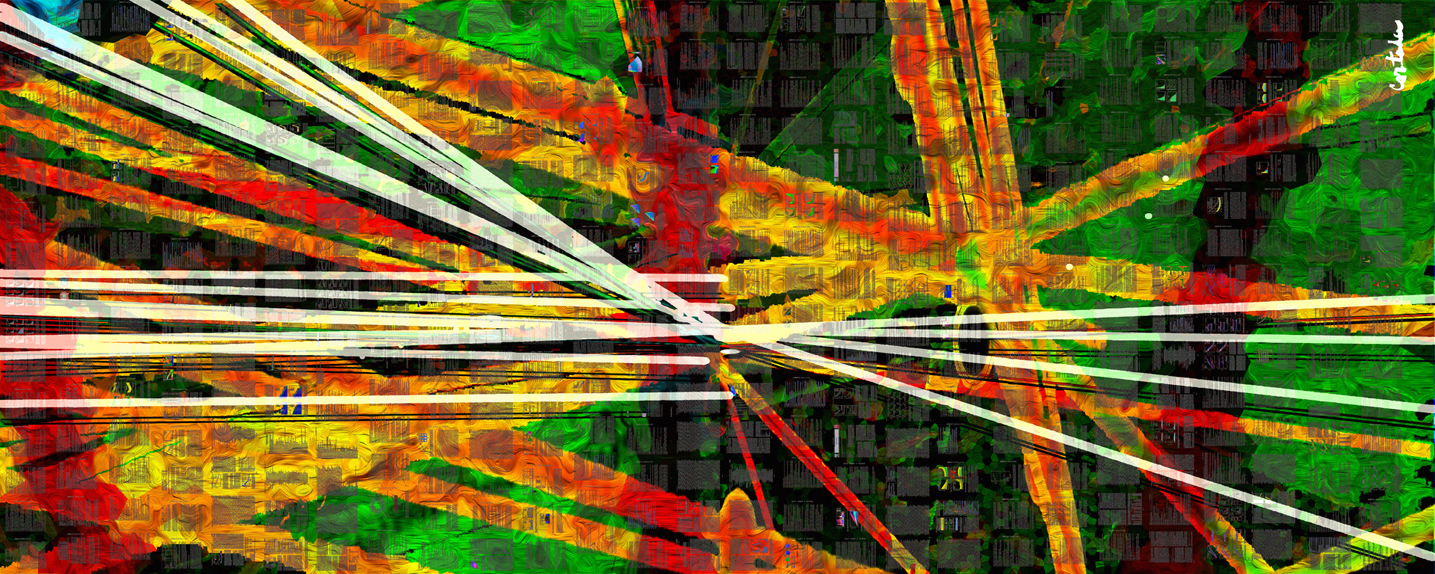
|
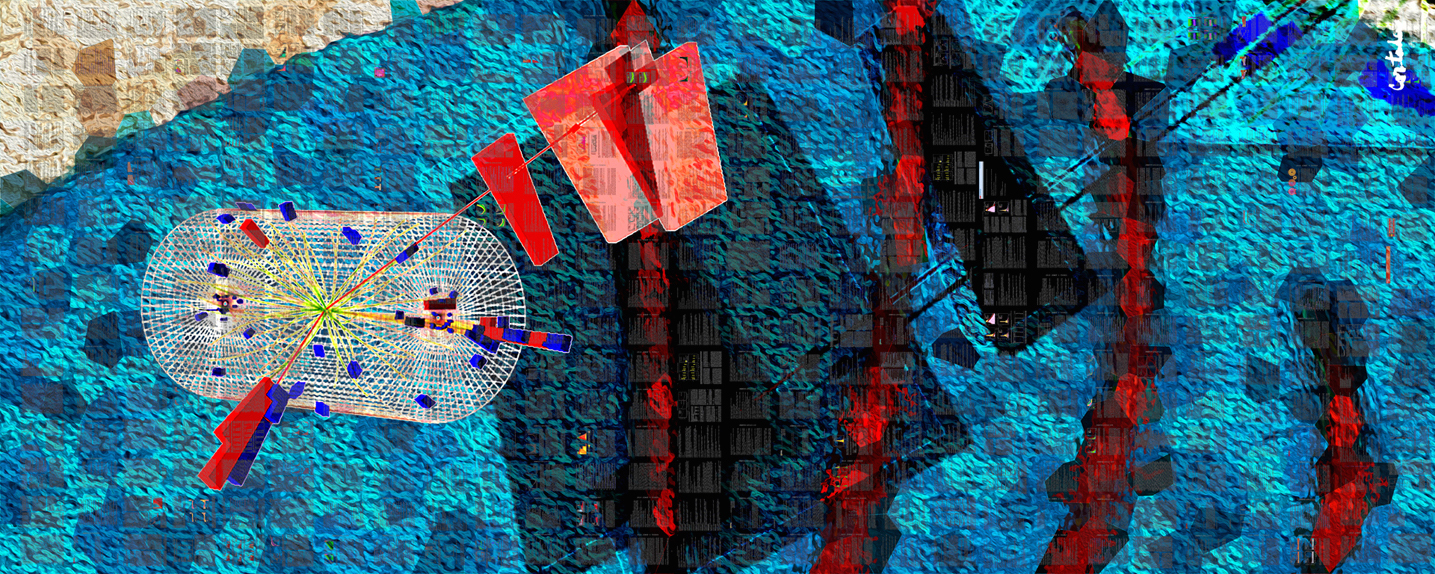
|
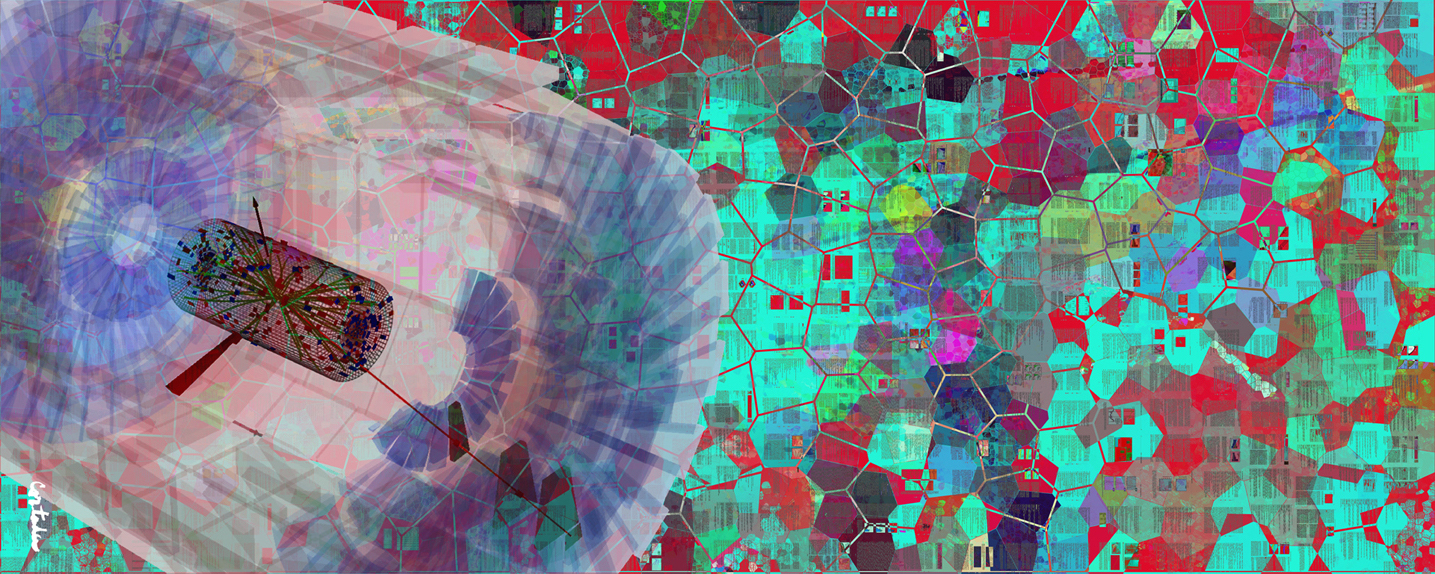
|